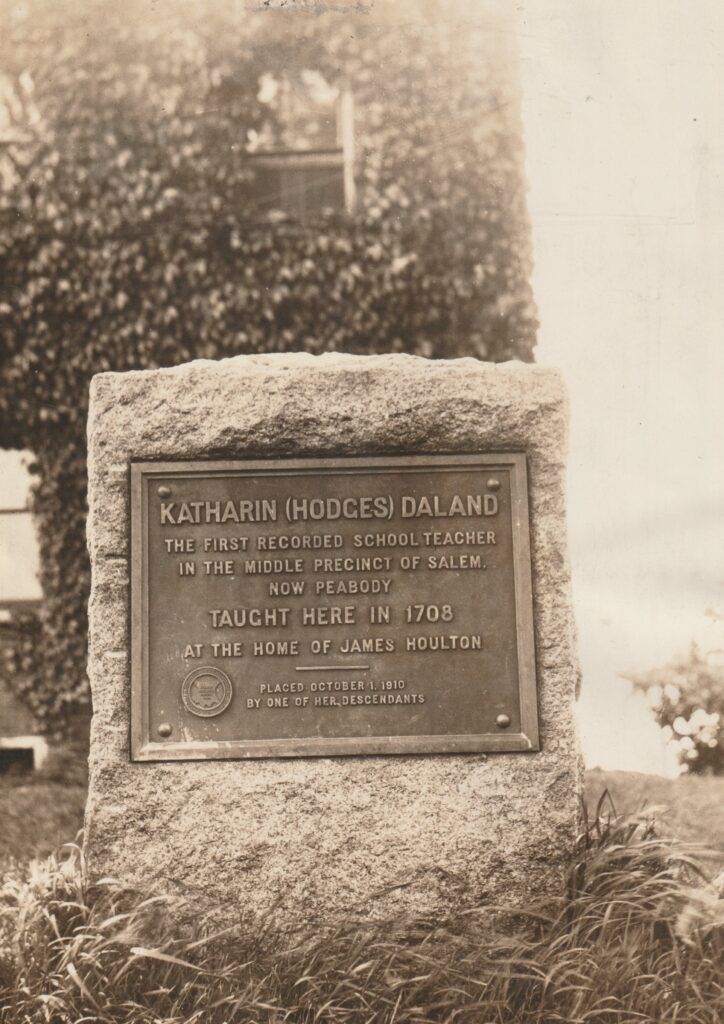With back to school around the corner, we are devoting this week’s First Lady Friday to a pioneer teacher, Katharin Hodges Daland.
We will be doing other educators and education advocates in the future, such as Annie McCarthy and Maggie McBreen. Feel free to reach out with any other women you would like us to spotlight!
Katharin Hodges Daland is the first recorded schoolteacher in Peabody (then part of Salem’s Middle District). Daland taught at the home of James Houlton on Prospect Street from 1708 to 1712.

Site of James Houlton’s House on Prospect Street; this house, the second on this site, was built in 1816.
Katharin Hodges was born on August 20, 1664 to George and Mary Hodges on Essex Street in Salem, Massachusetts. Mary Hodges died in November of 1665, and Katharin was adopted by Katharine and Thomas Rootes. Family tradition indicates that Katharin stayed with her adopted mother’s family in 1680 in Boston and received some formal education.
In 1681, at the age of 17, Katharin Hodges married Benjamin Daland of Beverly. They had four children: Mary (b. 1683), Benjamin (b. 1686), John (b. 1688) and George (b. 1689). Sadly, on November 23, 1691, Benjamin Daland died, leaving Katherin a widow with four young children. She relied on the kindness of family, friends and her church in the first years after her husband’s passing. In 1700, she inherited the home of Katharine and Thomas Rootes, which she sold to John Masury.
In 1708, Rev. Joseph Green recruited Daland to start a school for the children of Salem Village, located at the home of James Houlton.

Daland’s signature from 1713, where she accepted payment of 5 pounds for teaching; Daland’s signature also appeared in 1700 on the deed, selling her inheritance from the Rootes. They are of the same hand.
In 1714, the town bought the house of Robert Pease at 62 Central Street for the first school in Salem’s Middle District (now Peabody). Daland was named its first school teacher. Salem designated 5 pounds to start a school teaching children in the Middle District “reading, writing and cyphering.”
In 1737, Peabody had 4 schools, 6 male teachers and 10 female teachers. The male teachers received 2 pounds a month and the women 6 pence per week. School was not free for all students until 1768, when Massachusetts mandated universal education to be funded through taxes.
The home of James Houlton on Prospect Street burned down in 1816. It was replaced by another brick house by then owner Rev. Thorndike Proctor. Daland’s descendent, Dr. Myron Chamberlain, had a plaque and stone marker placed at the site of the Daland’s first classroom. When it was dedicated October 1, 1910 by the Peabody Historical Society, there was about 100 people in attendance. Today, the plaque sits behind the North Shore Mall, across the street, on Prospect Street.

Photograph: Plaque, October 1, 1910
References
The Peabody Historical Society, Fifteenth Annual Report and Address by George H. Martin at the Unveiling of the Tablet in Memory of “Katharin Daland” (1910-1911), October 1910.
John Wells. The Peabody Story. Essex Institute, 1972, pages 199-201.
